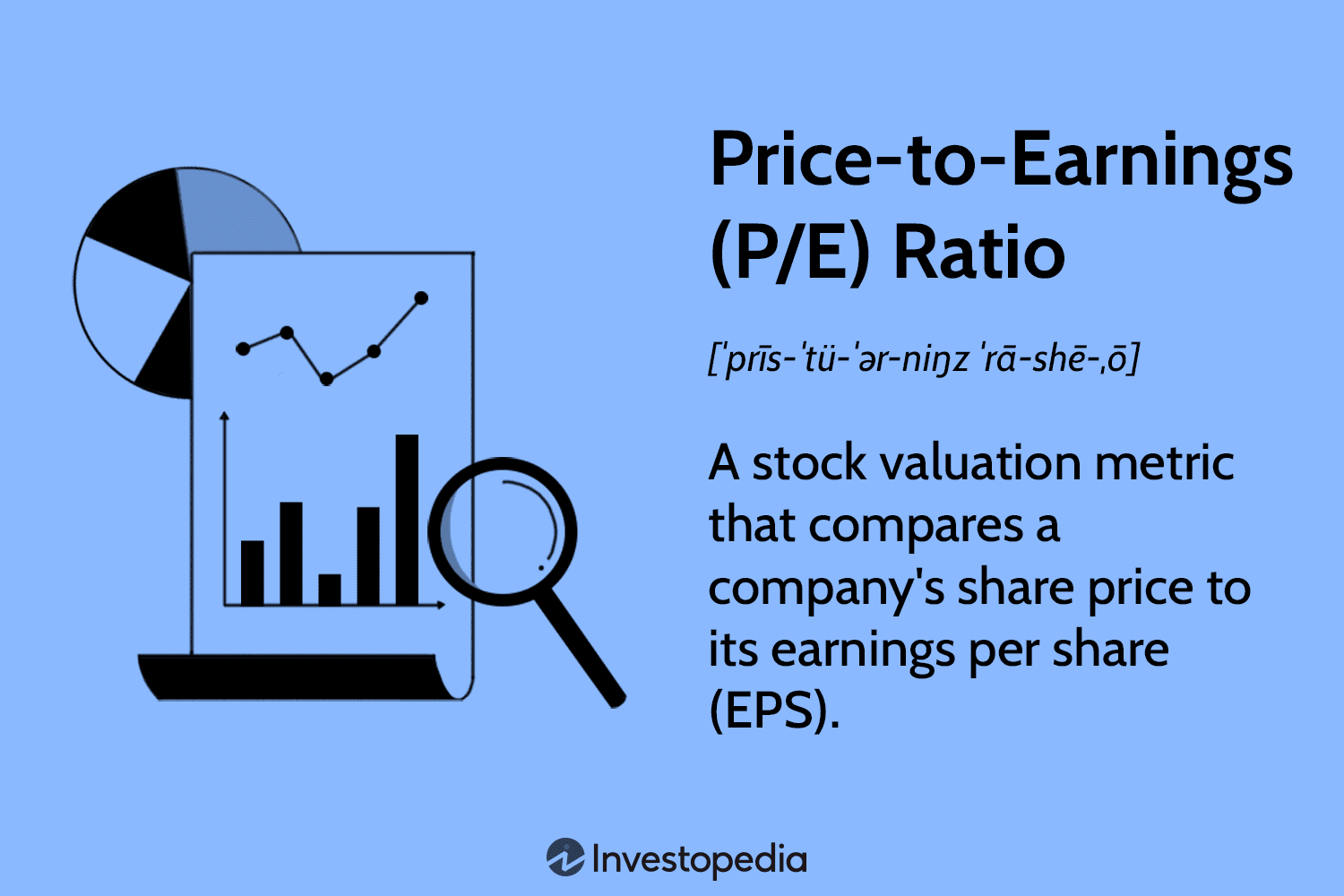Price-to-Earnings Ratio Formula, Meaning, and Examples: P/E/A/R Ratio

The Price-to-Earnings (P/E) Ratio, a cornerstone in monetary evaluation, measures a enterprise’s modern proportion charge relative to its in keeping with-proportion income. This ratio is pivotal for buyers seeking to apprehend a employer’s market cost in comparison to its earnings. By dividing the market price in keeping with proportion by means of the earnings in step with share (EPS), the P/E Ratio presents insights into whether or not a stock is hyped up, undervalued, or fairly priced. For example, a high P/E might advise overvaluation, commonplace in increase agencies waiting for better profits. Variations just like the P/E/A/R Ratio in addition refine this analysis, imparting a nuanced view of a organisation’s economic health and potential for growth.
Introduction to Price-to-Earnings (P/E) Ratio
The Price-to-Earnings (P/E) Ratio is a essential tool in monetary analysis, serving as a barometer for valuing a agency. By comparing a organization’s marketplace cost to its earnings, it helps traders parent how the market fees the organisation’s earning electricity. This ratio is critical for comparing investment possibilities, aiding in choices about shopping for or selling stocks based on their marketplace valuation relative to their financial overall performance.
Definition of P/E Ratio
The P/E Ratio is described as the market cost consistent with proportion divided by using the earnings consistent with proportion (EPS). It quantifies how a good deal investors are inclined to pay in step with greenback of profits. A better P/E suggests higher expectancies of destiny increase, whereas a decrease P/E may endorse a doubtlessly undervalued inventory or a corporation going through demanding situations. This ratio is essential in evaluating the relative price of companies within the identical industry or zone.
The Formula of P/E Ratio
A. Detailed Explanation of the P/E Ratio Formula
The Price-to-Earnings (P/E) Ratio system is expressed as the market price consistent with proportion divided by way of the profits according to share (EPS). This calculation reveals how an awful lot traders are purchasing a greenback of the corporation’s income, serving as a key indicator of marketplace expectancies and inventory valuation.
B. Variants of the P/E Ratio Formula
Different variations of the P/E Ratio, consisting of trailing P/E and forward P/E, cater to numerous analytical needs. Trailing P/E uses the past twelve months’ profits, imparting a reality-based perspective, while ahead P/E is based on forecasted income, providing a glimpse into future ability. These variations enable extra nuanced checks of a enterprise’s financial standing and increase prospects.
Understanding the Meaning and Significance of P/E Ratio
A. How P/E Ratio Reflects Company Valuation
The P/E Ratio is a essential metric in assessing a corporation’s valuation. It shows how a lot buyers are inclined to pay for each dollar of income, with a higher P/E often reflecting greater marketplace self belief and perceived growth capability. This ratio allows gauge whether or not a inventory is overestimated or undervalued relative to its profits.
B. Comparison of P/E Ratio Across Different Industries
P/E Ratios range significantly across industries, influenced via sector-precise growth possibilities and risk factors. High-increase industries, like era, often have higher P/E ratios, reflecting expectancies of future income growth. In assessment, greater strong industries might exhibit lower P/Es, indicating mature, regular income streams.
C. Limitations and Considerations in Using P/E Ratio
While informative, the P/E Ratio has barriers. It would not account for debt levels, marketplace situations, or quarter variations. High P/E ratios might signal overvaluation or growth ability, necessitating a deeper evaluation of enterprise norms, company basics, and market developments. Investors must use it alongside different financial metrics for a comprehensive evaluation.
Understanding the Meaning and Significance of P/E Ratio
A. How P/E Ratio Reflects Company Valuation
The P/E Ratio is a vital metric in assessing a organisation’s valuation. It shows how plenty traders are willing to pay for each dollar of profits, with a higher P/E frequently reflecting more market self assurance and perceived boom potential. This ratio allows gauge whether or not a stock is overestimated or undervalued relative to its income.
B. Comparison of P/E Ratio Across Different Industries
P/E Ratios range significantly throughout industries, motivated through region-precise boom possibilities and chance factors. High-boom industries, like generation, often have better P/E ratios, reflecting expectations of destiny earnings growth. In evaluation, extra strong industries may showcase decrease P/Es, indicating mature, constant profits streams.
C. Limitations and Considerations in Using P/E Ratio
While informative, the P/E Ratio has barriers. It does not account for debt degrees, market situations, or zone variations. High P/E ratios would possibly sign overvaluation or growth ability, necessitating a deeper evaluation of enterprise norms, organization fundamentals, and marketplace traits. Investors need to use it alongside other monetary metrics for a complete assessment.
Real-World Examples of P/E Ratio
A. Case Studies of Different Companies’ P/E Ratios
In real-global scenarios, corporations like Apple and Amazon showcase varying P/E Ratios. Apple, with a traditionally stable P/E, displays steady investor confidence and consistent boom. In evaluation, Amazon’s regularly higher P/E Ratio signals aggressive increase expectancies, no matter fluctuating earnings.
B. Analysis of What These Ratios Indicate About the Companies
A corporation’s P/E Ratio offers insights into marketplace perceptions and boom expectations. A lower P/E may endorse undervaluation or mature, slower growth, common in utilities or production. Conversely, a high P/E, regularly visible in tech or biotech corporations, shows anticipated speedy boom, albeit with capability overvaluation dangers.
Advanced Variations of P/E Ratio (P/E/A/R Ratio)
A. Explanation of P/E/A/R Ratio and How It Differs from Traditional P/E Ratio
The P/E/A/R Ratio, a sophisticated variant of the traditional P/E Ratio, consists of Adjusted Earnings and Revenue into the valuation metric. This adjustment money owed for non-ordinary gadgets in profits and revenue fluctuations, providing a more comprehensive and accurate assessment of a business enterprise’s monetary fitness as compared to the standard P/E Ratio.
B. Importance and Applications of P/E/A/R Ratio in Financial Analysis
In monetary analysis, the P/E/A/R Ratio is precious for its more suitable accuracy in comparing agency performance. It mitigates the effect of one-time activities and sales inconsistencies, providing a clearer photograph of sustainable earnings and boom developments. This makes it especially useful for traders and analysts in making greater informed choices, especially in industries with volatile earnings or sales streams.
Also Read: “λιβαισ”: A Classic History of Denim and Fine Craftsmanship
Conclusion:
In end, the Price-to-Earnings (P/E) Ratio and its superior versions, just like the P/E/A/R Ratio, are necessary tools in economic analysis. These metrics no longer best offer a image of a company’s current valuation but additionally provide insights into marketplace perceptions and future growth potentialities. While the traditional P/E Ratio offers a baseline knowledge of ways a stock is valued towards its income, advanced versions like P/E/A/R provide a extra nuanced view, thinking about adjusted earnings and revenue. However, it’s critical to don’t forget that these ratios are most effective while used along with other monetary analyses, as they are stimulated with the aid of different factors consisting of marketplace developments, industry norms, and organization-specific instances.





